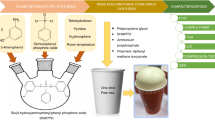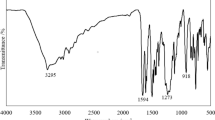Abstract
The objective of this work is to study the detailed effects of flame-retardant on the pyrolysis behaviors of XPS foams. Thermogravimetric experiments are conducted in air atmosphere for flame-retardant and three XPS foams at different heating rates. The results show that the DTG peak of flame-retardant is higher at much lower temperatures than that of the flame-retardant foams and non-retardant one. It surprisingly suggests that the DTG peak of B2-retardant XPS foam is higher than that of B1-retardant one although more flame-retardant has been added into B1-retardant sample during manufacturing. The detailed DTG curves in local temperature ranges (260–360 °C) explain the non-monotonic effects of flame-retardant mass fraction on the pyrolysis behaviors of XPS foams. It is also reminded that the DTG peaks information is not always enough in analyzing the pyrolysis of flame-retardant materials in research and development. Detailed DTG curves in specific temperature ranges might reveal some more important technical and even philosophical principles. Finally, a proper difference between the temperatures for DTG peaks of flame-retardant and the polymers can be one of the key parameters in searching for new flame-retardants for various polymers.





Similar content being viewed by others
References
Levchik SV, Weil ED. New developments in flame retardancy of styrene thermoplastics and foams. Polym Int. 2008;57:431–48.
Wang Z, Du XH, Yu HO, Jiang ZW, Liu J, Tang T. Mechanism on flame retardancy of polystyrene/clay composites—the effect of surfactants and aggregate state of organoclay. Polymer. 2009;50:5794–802.
Cao B, Gu XY, Song XH, Jin XD, Liu XY, Liu XD, Sun J, Zhang S. The flammability of expandable polystyrene foams coated with melamine modified urea formaldehyde resin. J Appl Polym Sci. 2017;34:44423.
Chen RY, Lu SX, Li CH, Ding YM, Zhang BS, Lo SM. Correlation analysis of heat flux and cone calorimeter test data of commercial flame-retardant ethylene-propylene-diene monomer (EPDM) rubber. J Therm Anal Calorim. 2016;123:545–56.
Pan HF, Lu YS, Song L, Zhang XT, Hu Y. Fabrication of binary hybrid-filled layer-by-layer coatings on flexible polyurethane foams and studies on their flame-retardant and thermal properties. RSC Adv. 2016;6:78286–95.
Wang G, Chen X, Liu PJ, Bai SB. Flame-retardant mechanism of expandable polystyrene foam with a macromolecular nitrogen–phosphorus intumescent flame-retardant. J Appl Polym Sci. 2017;134:44356.
Ferriol M, Gentilhomme A, Cochez M, Oget N, Mieloszynski JL. Thermal degradation of poly(methyl methacrylate) (PMMA): modelling of DTG and TG curves. Polym Degrad Stab. 2003;79:271–81.
Liu JC, Zhang YB, Peng SG, Pan BL, Lu C, Liu HY, Ma J, Niu QS. Fire property and charring behavior of high impact polystyrene containing expandable graphite and microencapsulated red phosphorus. Polym Degrad Stab. 2015;121:261–70.
Wang X, Hu Y, Song L, Xing WY, Lu HD, Lv P, Jie GX. Flame retardancy and thermal degradation mechanism of epoxy resin composites based on a DOPO substituted organophosphorus oligomer. Polymer. 2010;51:2435–45.
Wang X, Hu Y, Song L, Xing WY, Lu HD. Thermal degradation behaviors of epoxy resin/POSS hybrids and phosphorus–silicon synergism of flame retardancy. J Polym Sci Polym Phys. 2010;48:693–705.
Xie QY, Zhang HP, Tong L. Experimental study on the fire protection properties of PVC sheath for old and new cables. J Hazard Mater. 2010;179:373–81.
Wang SP, Chen HX, Zhang LH. Thermal decomposition kinetics of rigid polyurethane foam and ignition risk by a hot particle. J Appl Polym Sci. 2014;131:39359.
Zhang Y, Huang XJ, Wang QS, Ji J, Sun JH, Yin Y. Experimental study on the characteristics of horizontal flame spread over XPS surface on plateau. J Hazard Mater. 2011;189:34–9.
Wang Y, Zhang J. Thermal stabilities of drops of burning thermoplastics under the UL 94 vertical test conditions. J Hazard Mater. 2013;246:103–9.
Luo SF, Xie QY, Tang XY, Qiu R, Yang Y. A quantitative model and the experimental evaluation of the liquid fuel layer for the downward flame spread of XPS foam. J Hazard Mater. 2017;329:30–7.
Acknowledgements
This work was supported by the National Natural Science Foundation of China (51476157), the Shanghai Natural Science Foundation (15ZR1408100), the Fundamental Research Funds for the Central Universities (WK2320000032, WK2320000035). The authors thankfully acknowledge all these supports.
Author information
Authors and Affiliations
Corresponding author
Rights and permissions
About this article
Cite this article
Yang, Y., Xie, Q. & Tang, X. Trace analyses of flame-retardant in pyrolysis of XPS foams and its revelation for flame-retardant optimization. J Therm Anal Calorim 132, 1893–1898 (2018). https://doi.org/10.1007/s10973-018-7064-7
Received:
Accepted:
Published:
Issue Date:
DOI: https://doi.org/10.1007/s10973-018-7064-7




